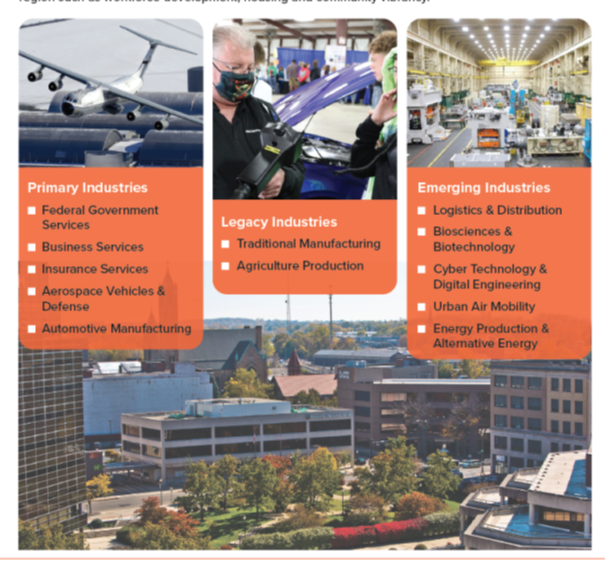- Log in to post comments
EXECUTIVE SUMMARY
The Miami Valley Regional Planning Commission (MVRPC) and The Dayton Development Coalition (DDC) partnered with the U.S. Economic Development Administration (EDA) to update to the Comprehensive Economic Development Strategy (CEDS) for the Dayton Region.
Titled Dayton Region Economic Development Strategy, the CEDS is a strategy-driven plan to strengthen, diversify and build resiliency for our Regional economy. A current and EDA-compliant CEDS is necessary because it is a pre-requisite for many critical funding and technical assistance opportunities available through the Department of Commerce for government, higher-education, non-profit and economic development organizations to accomplish the goals set out in this plan. The adoption of the Dayton Region Economic Development Strategy establishes an agreed upon set of strategic priorities, goals and objectives, along with an evaluation framework, that will guide regional economic development efforts through 2026 and beyond.
The Dayton Region is anchored by the cities of Dayton and Springfield, Ohio and includes the following 13 counties in Southwest Ohio: Auglaize, Butler, Champaign, Clark, Clinton, Darke, Greene, Mercer, Miami, Montgomery, Preble, Shelby, and Warren.
The major outcomes of the CEDS process include:
■ identification of regional priorities
■ streamlining and coordination of regional resources
■ diversification of our economy for greater resilience
■ impact on equity and increased opportunity for all
■ economic development efforts extend across all sectors and geographic areas
■ increase in access to funding and technical assistance to implement the CEDS plan strategies.
MVRPC and DDC leveraged both agencies’ existing member and stakeholder groups in the Dayton Region Economic Development Strategy planning process. Particular efforts were made to engage private and public sector leaders from each of the participating counties, major industries, entrepreneurs and critical workforce partners to ensure that the Dayton Region Economic Development Strategy reflects the priorities and needs of our entire region. A summary of stakeholder engagement can be found in Appendix IV.
The Dayton Region has experienced economic momentum in the past decade, as evidenced by the 4.9% increase in jobs, the 3.4% reduction in unemployment, the 25.5% increase in per capita income and the 19.7% increase in median household income. This progress is critical to note because it demonstrates a reversal of the trend from 2001-2011 when our region lost jobs each year, and major regional industries such as manufacturing experienced a devastating 32% loss of jobs. Despite the data confirming a bounce-back of our regional economy, concerns remain because per capita income in our region still lags behind state and national data for the same time period. Furthermore, our region’s overall population growth in the past decade is 2.5%. This is lower than the national average and not enough to keep up with the pace of job creation, creating a burdensome workforce shortage. While the data for our region is trending upward overall, progress is uneven. Underserved and minority populations throughout the region experience higher rates of poverty and unemployment, limited access to opportunity, and lower rates of educational attainment and workforce readiness.
The Dayton Region Economic Development Strategy identifies the primary industries that are the current backbone of our regional economy, as well as the legacy industries that have built our economy in the past and the emerging industries that will fuel our economic success in the future. Strategies throughout the plan support technological innovation and invention as drivers of regional growth. The plan also addresses critical contributing components of successful economic advancement for our region such as workforce development, housing and community vibrancy.
Primary Industries
■ Federal Government Services
■ Business Services
■ Insurance Services
■ Aerospace Vehicles & Defense
■ Automotive Manufacturing
Legacy Industries
■ Traditional Manufacturing
■ Agriculture Production
Emerging Industries
■ Logistics & Distribution
■ Biosciences & Biotechnology
■ Cyber Technology &Digital Engineering
■ Urban Air Mobility
■ Energy Production & Alternative Energy
The Dayton Region Economic Development Strategy outlines five Priority Areas, each with a corresponding framework of goals, strategies, tactics and resources.
Priority 1: Talent and Workforce
The Dayton Region develops, attracts and retains diversified talent, encouraging workforce readiness and resilience.
Priority 2: Infrastructure
The Dayton Region features a well-connected, well-funded, reliable and well-maintained network of critical 21st century infrastructure.
Priority 3: Vibrant Communities
The Dayton Region benefits from dynamic and diverse communities with vibrant quality of life that attracts new investment.
Priority 4: Small Business & Entrepreneurship
The Dayton Region cultivates and nurtures a thriving business and entrepreneurial ecosystem.
Priority 5: Resilient Economy
The Dayton Region maintains a growing, diversified, and resilient economy
The participants in this plan are united around a common vision for our Region’s future, and the strategic priorities that will enable us to make that vision a reality. The Dayton Region Economic Development Strategy leverages our leadership, assets and resources to propel economic growth, resiliency, and equitable access to opportunity throughout the entire region. For more information and plan updates, please visit mvrpc.org/ceds.
